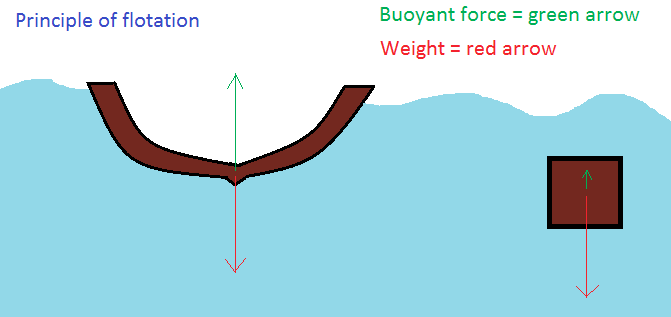Law of flotation
The law of flotation states that a floating object displaces a weight of fluid equal to its own weight. Keep reading to see why this is so!
In the previous lesson, we saw that if the density of the object is bigger than the density of water, the object will sink.
Consider for example, a block of iron that is submerged in water.
The density of water is 1 g / cm³
The density of iron is 8 g / cm³
Since the density of iron is bigger than the density of water, the block of iron will not float.
However, how is it possible then to make a huge cruise ship made of iron float such as the oasis of the sea?
How much water is being displaced and the resulting buoyant force are the key concepts here!

Since water has a density of 1 g / cm³, an object with a mass of 1 gram will displace 1 cm³ of water. This makes sense since the amount of water that is displaced is equal to the weight of the object and 1 cm³ is equivalent to 1 g.
We can also use the formula below
What about the block of iron? We know it will sink, but how much water can it displace?
The block of iron will displace 1 cm³ of water. Since the buoyant force or force that pushes the object up is equal to the amount of water that is displaced, the buoyant force is 1 cm³.
1 cm³ is equivalent to 1 g. A buoyant force of 1 g is not enough to prevent a mass of 8 grams from sinking.
Notice also that 1 gram is one-eighth of the mass of 8 grams.
If the weight of a block of iron is 16000 tons, it will only displace 2000 tons of water and again 2000 tons is not enough to overcome 16000 tons.
What can we do? We need to displace more water, but how?
You need to reshape the block of iron and make it look like a bowl as shown above.
Now the block of iron will displace a greater volume of water than before. Therefore, the buoyant force will be bigger than before.
When the weight of the displaced water is equal to the weight of the bowl, the bowl will no longer sink.
So, if you don't want something to sink, make sure that the amount of water that thing displaces is bigger or equal to the weight of that thing.
Law of flotation and cruise ship
A cruise ship for instance made with a block of iron weighing 50000 tons must be made in a way to displace a weight of water bigger than 50000 tons.
If you can do this, the cruise ship will float. This is the reason why the bottom of many cruise ships is shaped like bowl.
This is the law of flotation!